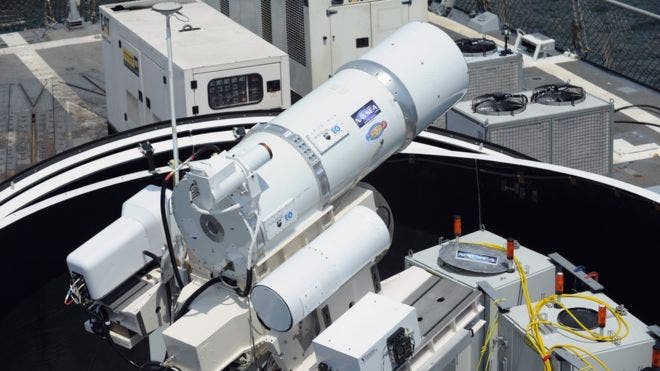The UK military is betting a lot of money on lasers. The Ministry of Defence has officially signed a £30m contract to produce a prototype directed energy weapon, to be tested by the end of the decade.

Why go through the effort of producing bullets, boxing, transporting, then shooting them, when you can fire pure science at the enemy? That’s a question the UK Ministry of Defence is willing to pay £30m to answer. A consortium led by Stevenage-based missile company MBDA which includes QinetiQ, Leonardo-Finmeccanica, GKN, Arke, BAE Systems and Marshall has been awarded the contract to build the prototype for the laser weapon system, named “Dragonfire”.
Ahead of the curve
The contract has been in the making for a few months now, but the MoD has finally put the seal of approval on the consortium. Delivery of the prototype is expected for 2019, when the military will test its ability to lock onto and track targets at various distances in all weather conditions for land and water applications.
The MoD’s endgame goal, however, is loftier than “Dragonfire” alone — they want to know if ‘energy’ could become the next ‘ammo’. As Peter Cooper of the UK’s Defence Science and Technology Laboratory (DSTL) said:
“This is a significant demonstration program aimed at maturing our understanding of what is still an immature technology.”
“It draws on innovative research into high power lasers so as to understand the potential of the technology to provide a more effective response to the emerging threats that could be faced by UK armed forces.”
MBDA spokesman Dave Armstrong said that the project will propel the UK to “the forefront of high energy laser systems”.
“Furthermore, it advances the UK towards a future product with significant export potential, as well as providing opportunities for partnerships with other nations’ armed forces that have similar requirements,” he added.
Harriet Baldwin, the Minister for Defence Procurement, thinks projects such as this one will “keep this country ahead of the curve”. But this isn’t the first time a country has toyed with the idea of directed energy weapons. The US has been experimenting with laser weapons for decades now. Their efforts culminated with the testing of a weapon dubbed ‘Laws’ on the USS Ponce in the Arabian Gulf in 2014. The system successfully targeted a small boat directed towards the ship and shot down a small drone. Still, no-one has had the technological oomph to bring such guns on the front line up to now.
If it proves itself reliable, weapons such as the Dragonfire could be used to take down drones, jets, or strategic missiles, as well as point defense systems against mortar shells, missiles, roadside bombs and various other threats.
Bringing a laser to a knife fight

Image credits John F. Williams / US Navy.
The MoD said that the weapon isn’t being developed to counter any specific threat, only to see what advantages such weapons could bring to their armed forces. But with growing global instability, tensions rising in eastern Europe, and Russia’s much publicized recent improvements in armament and weapon systems (such as the RS-28 ICBM, dubbed ‘Satan 2’), the Dragonfire could have a more specific purpose in mind than simple research.
I’ve always been a military technology buff, and I nerd out over anything from copper daggers to tanks, battleships, and Star Destroyers — and the Dragonfire is bound to be a solid piece of technology and applied science. But no matter how much I’ve enjoyed the laser-drenched dogfight scenes in Star Wars, I can’t help but feel saddened to see science twisted into destroying things and killing people. Especially in a time when disarmament and working together to solve greater problems should come at the forefront.
But the contract is signed and the proverbial wheels are turning. Time will tell if the Dragonfire will turn out to be just another straw, or a lit match, thrown in the haystack.






